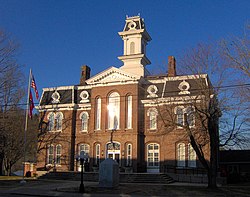Carthage, Tennessee | |
|---|---|
 Smith County Courthouse in Carthage | |
 Location of Carthage in Smith County, Tennessee. | |
| Coordinates: 36°15′18″N85°56′57″W / 36.25500°N 85.94917°W | |
| Country | United States |
| State | Tennessee |
| County | Smith |
| Settled | 1789 |
| Incorporated | 1804 [1] |
| Named after | Ancient Carthage [2] |
| Area | |
• Total | 2.90 sq mi (7.52 km2) |
| • Land | 2.90 sq mi (7.52 km2) |
| • Water | 0 sq mi (0.00 km2) |
| Elevation | 515 ft (157 m) |
| Population | |
• Total | 2,291 |
| • Density | 789.4/sq mi (304.78/km2) |
| Time zone | UTC-6 (Central (CST)) |
| • Summer (DST) | UTC-5 (CDT) |
| ZIP code | 37030 |
| Area code | 615 |
| FIPS code | 47-11280 [5] |
| GNIS feature ID | 1279827 [6] |
| Website | townofcarthagetn |
Carthage is a town in and the county seat of Smith County, Tennessee, United States; it is part of the Nashville Metropolitan Statistical Area. [7] The population was 2,306 at the 2010 census. [8] It is located on the Cumberland River, which was important to its early development. It is best known as the hometown of former U.S. Vice President and Senator Al Gore of the Democratic Party and his father, Senator Albert Gore, Sr. The younger Gore announced his 1988 and 2000 presidential bids, as well as his 1992 vice-presidential bid, from the steps of the Smith County Courthouse.



